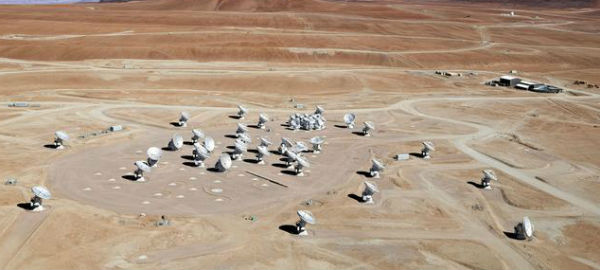“In Search of Our Cosmic Origins (The ALMA Movie)”

This 16-minute video presents the history of ALMA from the origins of the project several decades ago to the recent first science results. Illustrated by dramatic helicopter footage, the movie takes you on a journey to the 5000-metre-high Chajnantor Plateau, where ALMA stands, in the unique environment of the Atacama Desert of Chile.

The birth of ALMA dates back to the end of the last century. Large millimeter/submillimeter array radio telescopes were studied by astronomers in Europe, North America and Japan and different possible observatories had been discussed. After thorough investigations, it became obvious that the ambitious projects of all of these studies could hardly be realized by a single community.
Consequently, a first memorandum was signed in 1999 by the North American community, represented through the NSF (National Science Foundation), and the European community, represented through ESO (European Organisation for Astronomical Research in the Southern Hemisphere), followed in 2002 by an agreement to construct ALMA on a plateau in Chile.
Thereafter, Japan, through the NAOJ (National Astronomical Observatory of Japan), worked with the other partners to define and formulate its participation in the ALMA project. An official, trilateral agreement between ESO, the NSF, and the National Institutes for Natural Sciences (NINS, Japan) concerning the construction of the enhanced Atacama Large Millimeter / submillimeter Array was signed in September 2004. This agreement was subsequently amended in July 2006.
NAOJ will provide four 12-meter diameter antennas and twelve 7-meter diameter antennas for a compact array (ACA), the ACA correlator and three receiver bands. With the inclusion of the Asian partners, ALMA has become a truly global astronomical facility, involving scientists from four different continents.
Credit: ALMA (ESO/NAOJ/NRAO)
Featured image: An aerial view of the Chajnantor Plateau, located at an altitude of 5000 meters in the Chilean Andes, where the array of ALMA antennas is located. The large antennas have a diameter of 12 metres, while 12 smaller antennas with a diameter of 7 metres make up the ALMA Compact Array (ACA). (Credit: Clem & Adri Bacri-Normier/ESO)

Commenting rules and guidelines
We value the thoughts and opinions of our readers and welcome healthy discussions on our website. In order to maintain a respectful and positive community, we ask that all commenters follow these rules:
We reserve the right to remove any comments that violate these rules. By commenting on our website, you agree to abide by these guidelines. Thank you for helping to create a positive and welcoming environment for all.